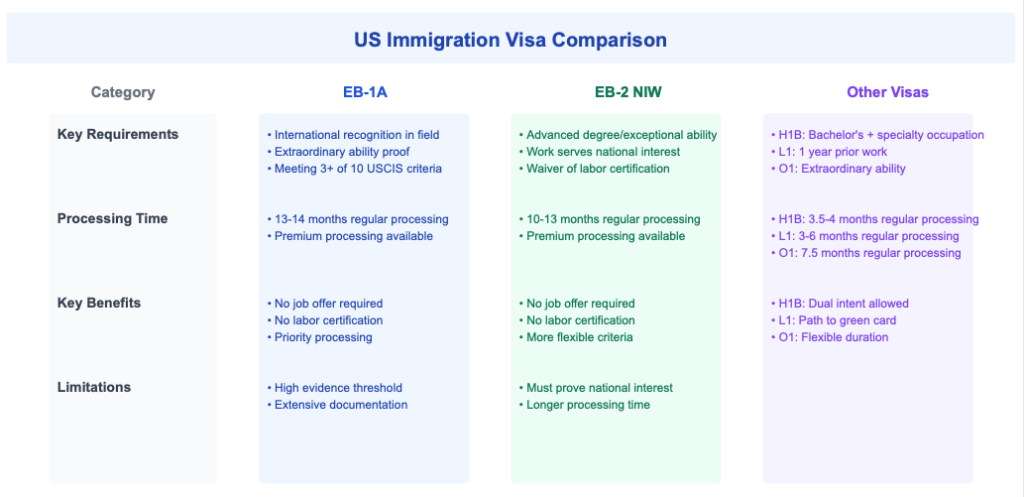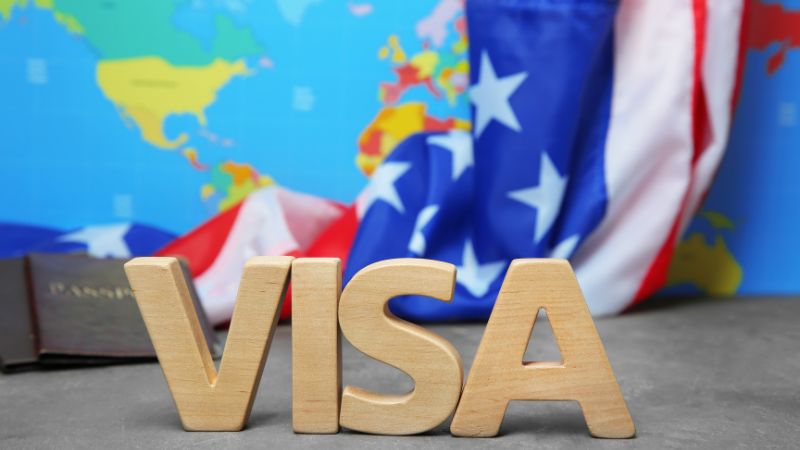Need Professional Help With Your Letters?
Get a quote for our specialized EB1A & EB2-NIW letter writing services
*We are professional writers specializing in crafting compelling recommendation letters and cover letters. For legal advice, please consult an immigration attorney.
Upgrading from EB-2 to EB-1 can change your immigration journey. This guide will help you understand the process of moving from EB-2 to EB-1. It’s about making your path to a U.S. green card smoother.
The EB-1 category is special because it has shorter wait times and is highly respected. If you’re in the EB-2 category and think you can move to EB-1, this could speed up your journey to permanent residency.
To move from EB-2 to EB-1, you must show you have extraordinary ability or are an outstanding researcher or executive. You’ll need to prepare well and document your achievements and contributions carefully.
The U.S. Citizenship and Immigration Services (USCIS) has updated its policy for EB-1 applicants. Now, there’s clearer guidance on what evidence you need. This update highlights the need for a strong case that meets the EB-1 standards.
Understanding EB-2 and EB-1 Green Card Categories
The U.S. has different paths for skilled professionals through the employment-based green card system. We’ll look at the EB-2 and EB-1 visa categories to help you understand your path to permanent residency.
EB-2 Green Card: Advanced Degree Professionals and Exceptional Ability
The EB-2 visa is for professionals with advanced degrees or exceptional skills in sciences, arts, or business. It needs labor certification and has a long wait. For example, those from India can wait about 10 years for an EB-2 green card.
EB-1 Green Card: Extraordinary Ability, Outstanding Researchers, and Multinational Executives
The EB-1 visa is for people with extraordinary skills, leading researchers, and top executives from multinational companies. It has three subcategories: EB-1A, EB-1B, and EB-1C. Unlike EB-2, it doesn’t need labor certification and has shorter wait times. This makes it a popular choice for many.

Data as of Dec 12, 2024
Key Differences Between EB-2 and EB-1 Categories
EB-1 visas go to those with top talent or leadership roles. EB-2 visas are for those with advanced degrees or special skills. The wait for an EB-1 green card is shorter, about 2-4 years for Indians, compared to 10 years for EB-2. This makes moving from EB-2 to EB-1 a good option for many seeking quick permanent residency in the U.S.
Benefits of Converting from EB-2 to EB-1
Switching from EB-2 to EB-1 can make getting your green card faster. EB-1 has much shorter wait times, especially for those from countries with high visa demand. For instance, Indians face a 10-year wait for EB-2, but only 2-4 years for EB-1.
EB-1 has a big plus: no need for PERM Labor Certification. This cuts down on time and paperwork. Plus, you can file I-140 and I-485 together, which can speed up work authorization for your family.
Your place in line is kept when you move from EB-2 to EB-1. The 180-day rule lets you keep your application pending even if you change jobs, under certain conditions.
EB-1 is more demanding but faster to permanent residency. It brings more stability in your immigration status and opens doors for career growth in the U.S.
Green Card EB2 to EB1 Conversion: Eligibility and Requirements
The EB2 to EB1 conversion can make getting a green card faster. You must meet certain criteria to qualify. The EB1 category includes options for those with extraordinary ability, outstanding researchers, and multinational executives.
Qualifying for EB-1A: Extraordinary Ability
To get an EB-1A green card, you must show you have extraordinary ability in your field. You need to meet at least three out of ten criteria set by USCIS. These criteria include national awards, being featured in published materials, or making big contributions to your field.
It’s important to have strong evidence of your achievements. This will help you meet the strict requirements.
Qualifying for EB-1B: Outstanding Professors and Researchers
EB-1B is for outstanding researchers who have worked for at least three years. You must be recognized globally in your field. Proof of your expertise can be through published articles, patents, or speaking at conferences.
You also need a job offer from a U.S. research institution or university. This job must be in a field related to your research.
Qualifying for EB-1C: Multinational Managers or Executives
For EB-1C, you must have worked as a manager or executive for at least one year in the last three years. The U.S. company you work for must have been in business for over a year. You’ll need to show that your role was a key decision-maker.
Every year, USCIS approves about 140,000 employment-based green cards. A strong application that highlights your unique skills can boost your chances of success in this competitive process.

Step-by-Step Process for EB-2 to EB-1 Porting
The EB-2 to EB-1 porting process can make getting your green card faster. This guide will help you through the main steps for a smooth transition.
Assessing Your Qualifications
First, check if you fit the EB-1 criteria. This is for people with extraordinary skills, top professors or researchers, and high-level executives in multinational companies. Look at your achievements and skills to see if they match these needs.
Gathering Supporting Evidence
Next, gather solid evidence for your EB-1 case. This could be awards, publications, or proof of leadership. The better your evidence, the stronger your case will be when you submit it to USCIS.
Filing a New I-140 Petition
Then, work with an immigration lawyer to file a new I-140 petition. This is a key step for your EB-1 application. Your lawyer will make sure you have all the needed documents and they’re filled out correctly.
Retaining Your Priority Date
Porting also means you can keep your original EB-2 priority date. This can make your wait time much shorter, especially if you’re from a country with visa delays.

Conclusion
Upgrading your immigration status from EB-2 to EB-1 can change your career and U.S. immigration journey. This change offers quicker processing and better approval chances. The EB-1 is for highly skilled workers, successful academics, and top executives, helping you advance in your career.
While the EB-2 is for those with advanced degrees or special skills, trying for both EB-1 and EB-2 visas can increase your success chances. This approach shows you’re adaptable and resourceful in immigration. USCIS checks all applicants thoroughly to keep the U.S. safe and immigration honest.
U.S. immigration can be tough to navigate. You must keep your status until you file and know about INA 245(k) and INA 245(i). Remember, there’s a limit on immigrant visas each year, making EB-1 more appealing. By following this guide, you can greatly boost your immigration status upgrade chances.

